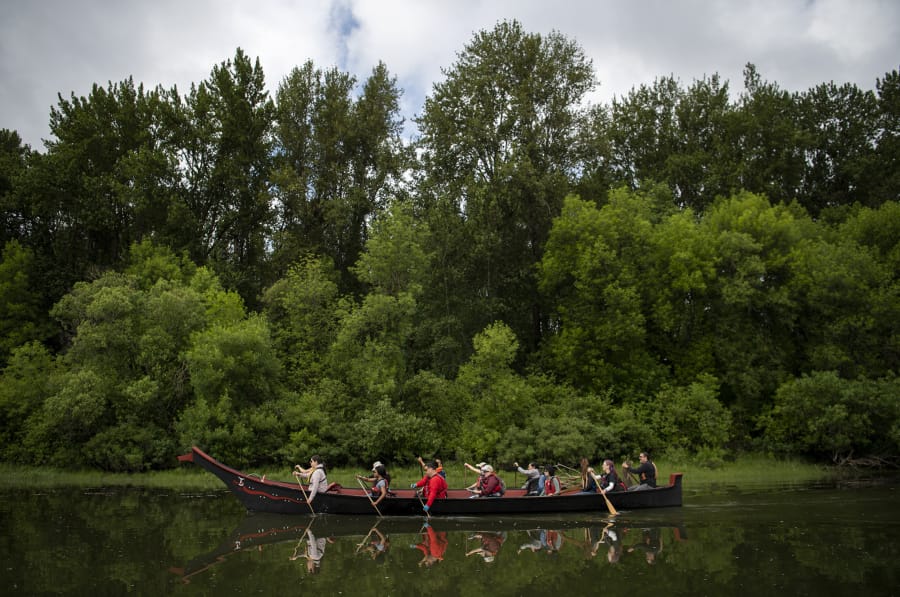RIDGEFIELD — Cottonwood seeds drifted through the air at Lake River, falling like snow on the calm water Tuesday as a class of Washington State University Vancouver students paddled a black and red canoe.
It’s not far from city life here, but for more than a dozen students and guests in a Native American literature class at WSU Vancouver, it feels a world away. This new English offering at the Vancouver campus is offered partly in a Chinook Indian Nation canoe, with members of the tribal council helping lead classes centered around Native Americans’ relationship to the region’s waterways.
Desiree Hellegers, an associate English professor, received a two-year, $28,000 Lewis E. and Stella G. Buchanan fellowship to overhaul the Native American literature class. The WSU program gives seed money for research and creative projects by associate English professors. Roben White, a member of WSU Vancouver’s Native American Community Advisory Board, helped develop the class.
“People have lost touch with the realities of how essential water is and how that reflects on the world around us,” said White, a Lakota and Cheyenne activist and local artist.
Speakers from the Nez Perce and Cowlitz Indian tribes will also join the class in the coming weeks, Hellegers said.
“We as a campus are committed to building Native representation in all elements of campus life,” she said.
The cornerstone of the class is these days spent paddling on the Lake and Columbia rivers, discussing the Native American history of the region and its relationship to these rivers. But it’s also a chance, Hellegers said, for students to speak to Native elders and tribal leaders in an effort to dispel “the myth of the ‘Disappearing Indian,’ ” while looking forward to the preservation of these waterways.
Put bluntly, “they’re going to find out that Indians aren’t all dead,” White said.
Tony Johnson is the chairman of the Chinook Indian Nation and served as skipper for these small-scale canoe journeys. From his position at the back of the canoe, Johnson steered the 36-foot vessel, offering tips to the amateur paddlers.
“Watch your tip; don’t let it go very far,” he directed the paddling students. “The canoe’s happiest when we’re all together.”
“It’s been a really immersive experience,” said Randal Houle, a 48-year-old English literature major. Houle is a descendent of the Salish tribe centered in Montana. Houle called his enrollment in the class, and the opportunity to hear from Native elders, “somewhat of a reclamation” of his own heritage.
“You can’t get better than that,” he said.
This canoe itself, named Kthlmin , is steeped in history for the Chinook Indian Nation. The canoe is named after a Chinookan chief who died with no heirs, and translates to “moon” in the tribe’s language. It was donated to the tribe in 2011 by the descendents of William Clark who, with Meriwether Lewis, stole a canoe from the Chinook people in 1806 before leaving the West Coast.
“This canoe is the result of almost 200 years of holding a grudge,” said Rachel Cushman, a councilwoman for the tribe.
Cushman and Johnson’s daughter, Mary Johnson, pulled the canoe from the front, setting the pace for the students paddling behind them. The elder Johnson estimates the pair have traveled thousands of miles together, leading canoe journeys up Puget Sound.
“It’s my opportunity to connect with my ancestors and the land that we come from,” Cushman said.
The Chinook Indian Nation, made up of five tribes centered in the Columbia River region, is in the midst of a centurylong battle for federal recognition. Chinook people have lived here for hundreds of years, but without recognition, receive none of the federal funds and benefits members are arguing in court they should be able to access.
To Tony Johnson, the future of these lands — and the public’s understanding of that fight — is critical.
“We benefit from an informed public,” Johnson said.
Along the way, Johnson kept a running commentary, from historic markers to pointing out the flora and fauna. He sang at times, breaking the otherwise quiet air with pace-keeping baritone vocals.
As the students pulled through the water toward Sauvie Island, Johnson pointed to historic locations along the way. On that bank, he said, Cathlapotle, a village occupied by hundreds of Chinookan people for hundreds of years — there’s still pits from the houses visible on the ground. Over there, he said, Native people buried baskets of acorns in the river bank to allow the bitter tannins to leach out. And here, he said as the group reached the spot where the Columbia River and Lake River converge, is Warrior Point, a spot named by Lt. William Broughton in 1792 when he encountered hundreds of Chinookans aboard canoes, wearing armored vests and holding weapons.
It’s an unfortunate name by the British naval officer, who was traveling with Capt. George Vancouver through the region. Only the white explorers readied their weapons for battle, according to the Oregon Historical Society, priming their muskets and readying a small cannon mounted on one of their boats. Broughton actually fired his musket into the water to try to intimidate the Chinook. The encounter ended in trading between the villagers and the explorers, but the name stuck.
Point the canoe toward the village, Johnson directed the students. He likes to think of that time, canoes sitting on the river, like they are now.
“We really believe that our ancestors and our relatives that still call that place home are smiling,” he said, pointing at the shore, “seeing this canoe here on the water.”




